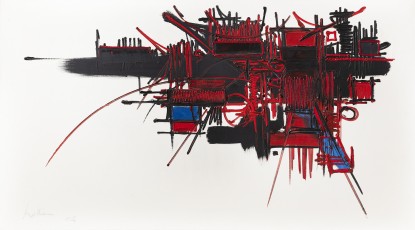Lines in Motion
Opera Gallery New York is proud to present ‘Lines in Motion’, a dynamic group exhibition exploring the expressive power of the line across painting, sculpture, and conceptual art. Spanning from the early 1950s to the present day, this exhibition invites visitors to discover how a single artistic gesture can convey emotion, movement, and meaning.
Lyrical Abstraction
The exhibition begins with the influential School of Paris, where artists such as Hans Hartung, Georges Mathieu, Serge Poliakoff, André Lanskoy, and Pierre Soulages redefined abstract painting in the wake of World War II. Here, the line becomes a gesture of freedom, expressed through splashes, stains, and energetic scribbles.
Mathieu’s In Cardamine (1964) captures the urgency of this moment, with sweeping red arcs and direct paint application from the tube. Decades later, Pierre Soulages’ Peinture 165 x 143 cm, 31 août 2020 continues the conversation with bold, black brushstrokes that shift in tone and texture as light moves across the canvas.
Russian émigré artists Serge Poliakoff and André Lanskoy, offer contrasting takes on abstraction. Poliakoff’s Composition abstraite (1958) uses flattened planes and primary colours to create visual poetry. In contrast, Lanskoy’s La Bataille d’Uccello (c. 1968) transforms Renaissance battle scenes into a vibrant tangle of colour and form, where lances and figures emerge from abstraction.
Optical Art
The 1960s ushered in new possibilities with the rise of technology, optics, and movement in art. Victor Vasarely, a pioneer of Op Art, leads this exploration with works like Anadyr-R (1956–1973), where bold geometry plays tricks on the eye. Across the ocean, Carlos Cruz-Diez advanced kinetic and optical art, particularly through his Physiochrome series, where intersecting lines and colours seem to shift with every step.
Art and Text
Contemporary artists take the line beyond traditional forms. In his iconic Joke series, Richard Prince transforms text into visual art, using humour to critique consumer culture, racism, and American absurdity. In contrast, Fred Eerdekens crafts delicate metal sculptures that cast shadows—revealing poetic phrases only when illuminated, merging light and line in surprising ways.
Sculptures
Extending into three dimensions, the line finds new life in sculpture. Pablo Atchugarry carves flowing, draped forms in white Carrara marble, while John Helton captures energy in dynamic bronze. Pieter Obels’ circular forms in Corten steel appear to hover effortlessly above their wooden plinths, suggesting both strength and suspension.
‘Lines in Motion’ invites you to explore the line not just as a mark, but as a force of emotion, space, rhythm, and history. From the post-war avant-garde to today’s contemporary sculptors and conceptual artists, this exhibition celebrates the line as a powerful tool of expression and transformation.
SELECTED WORKS
, 2004.jpg)
Sol Lewitt, Untitled (Wavy Lines), 2004
Gouache on paper
57.2 x 76.2 cm | 22.5 x 30 in

Fred Eerdekens, The heart of man is a dark forest, 2018
Copper, light source
18 x 90 x 14 cm | 7.1 x 35.4 x 5.5 in

Pierre Soulages, Brou de noix et collage sur papier marouflé sur toile 75 x 108 cm, 2004
Walnut stain on paper mounted on linen
75 x 108 cm | 29.5 x 42.5 in

Georges Mathieu, Cardamine, 1964
Oil on canvas
73 x 130 cm | 28.7 x 51.2 in

Victor Vasarely, Anadyr-R, 1956-1973
Oil on canvas
100 x 90 cm | 39.4 x 35.4 in

Pablo Atchugarry, Untitled, 2019
Carrara marble
154 x 31 x 22 cm | 60.6 x 12.2 x 8.7 in

Richard Prince, Untitled, 2008
Acrylic and collage on canvas
304.8 x 248.9 cm | 120 x 98 in

André Lanskoy, La Bataille d'Uccello, Circa 1968
Oil on canvas
97 x 195 cm | 38.2 x 76.8 in

Pieter Obels, I Can Never Say Goodbye, 2024
Corten steel on wooden base
175 x 80 x 60 cm | 68.9 x 31.5 x 23.6 in
